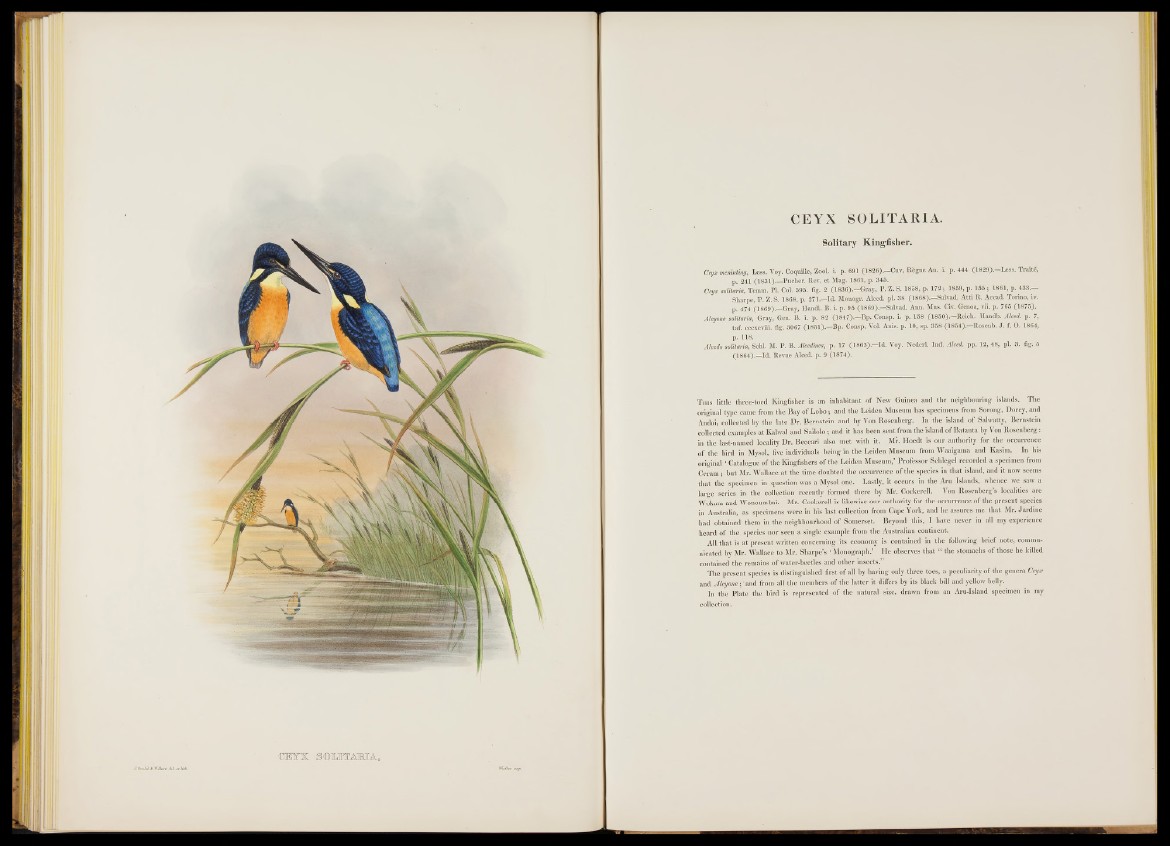
CEY X SOMTÁBIA.,
CEYX SOLITARIA.
Solitary Kingfisher.
Ceya meninting, Less. Voy. Coquille, Zool. i. p. 691 (1826),—Gùv. Règne An. i. p . 444 (1829).—Less. Traité,
p. 241 (1831).—Pueher. Rev. et Mag. 1861, p. 345.
Oeya soUtaria, Temm. PI. Col. 696. fig. 2 i(l8 3 6 ).-G ra y , P. Z. S. 1858, p. 172; 1859, p. 155 ; 1861, p. 433.—
Sharpe, P. Z. S. 1868, p. 271.—Id. Monogr. Alced. pi. 38 (1868).—Salvad. Atti R. Accad. Torino, It .
p. 474 ( 1869).—Gray, Hand'.. 11. i. p. 95 (1869).—Salvad. Ann. Mus. Civ. Genoa, vii. p. 765 (1875).
Alcyone solttaria, Gray, Gen. B. i. p. 8:2 (1847):—Bp. Consp. i. p. 158 (1 850g-R eich. Handh. Alced. p. 7,
taf. cccxcviii. fig. 3067 (1851).—Bp. Consp. Vol. Anis. p. 10, sp. 358 (1854).—Rosenb. J. f. O. 1864,
p . 118.
Alcedo solitaria, S o f t M. P. B. Alceimes, p. 17 (1863).—Id. Voy. Nederl. Ind. Alced. pp. 12, 48, pi. 3. fig. 5
(1864).—Id. Revue Alced. p. 9 (1874).
T his little three-toed Kingfisher is an inhabitant o f New Guinea and the neighbouring islands. The
original type came from the Bay o f L o b o ; and the Leiden Museum has specimens from Sorong, Dorey, and
Andai, collected by the late Dr. Bernstein and by Von Rosenberg. In the island o f Salwatty, Bernstein
collected examples a t Kalwal and Sailolo; and it has been sent from the island of Batanta by Von Rosenberg:
in the last-named locality D r. Beccari also m et with it. Mr. Hoedt is onr authority for the occurrence
o f the bird in Mysol, five individuals being in the Leiden Museum from Waaigama and Kasim. In his
original ‘ Catalogue o f the Kingfishers o f the Leiden Museum,’ Professor Schlegel recorded a specimen from
Ce ram ; but Mr. W allace a t the time donbted the occurrence o f the species in that island, and it now seems
th at the specimen in question was a Mysol one. Lastly, it occurs in the Aru Islands, whence we saw a
large series in the collection recently formed there by Mr. Cockerell. Von Rosenberg’s localities are
Wokam and Wonoumbai. Mr. Cockerell is likewise our authority for the occurrence o f the present species
in Australia, as specimens were in his last collection from Cape York, and he assures me th at Mr. Jardine
had obtained them in the neighbourhood o f Somerset. Beyond this, I have never in all my experience
heard o f the species nor seen a single example from the Australian continent.
All th at is a t present written concerning its economy is contained in the following brief note, communicated
by Mr. Wallace to Mr. Sharpe’s ‘ M onograph.’ He observes th at “ the stomachs o f those he killed
contained the remains of water-beetles and other insects.”
The present species is distinguished first o f all by having only three toes, a peculiarity o f the genera Ceyx
and Alcyone&x\& from all the members o f the latter it differs by its black bill and yellow belly.
In the Plate the bird is represented of the natural size, drawn from an Aru-Island specimen in my
collection.